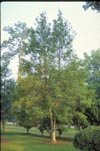Home >
Ilex x attenuata
'Savannah',
Savannah Holly
This holly grows quickly in full sun or partial shade on moist, acid soils. Growth is poor and foliage chlorotic on alkaline soil. Plants in full sun can grow a dense canopy, those in partial shade are more open. This plant is considered mostly allergy free and causes little or no allergy problems in most people. Trees attract cedar waxwings, mockingbirds, robbins and many other birds. A severe witches broom-like disease caused by Sphaeropsis fungus attacks and kills Ilex x attenuata cultivars in parts of Florida. This is a devastating disease that has caused some communities, horticulturists and landscape architects to discontinue using East Palatka Holly.
This holly makes a fairly durable street tree throughout its range except in the deep south where the plant will need sufficient space to explore plenty of soil space. It is quite drought-tolerant once it becomes well-established but can suffer in the extreme south in very dry years. Most trees are sheared in the nursery, unfortunately, and this practice is often repeated in the landscape after planting. The natural shape of the tree is rarely seen but is a graceful pyramid of drooping branches growing from a strong central trunk, laden with bright red berries which remain on the trees until eaten by birds. The crown grown with one central trunk is narrow, making it well-suited for urban areas having restricted vertical space. Savannah Holly has also performed well in sidewalk cutouts.
Multi-stemmed, topped, and trimmed trees grow a wider crown and are probably not as suited for narrow, limited-space downtown sites as their single-stemmed counterparts. The tree should be grown with a central trunk. Young trees which are topped in the nursery grow several upright, multiple trunks. These eventually droop to the horizontal and then become more weeping, creating an unkempt, asymmetrical mess. Training the tree into a single-trunked tree will increase its durability and resistance to storm-damage, although many nurseries offer multi-trunked specimens. The tree grows well even in small tree pits carved out of downtown sidewalks.
Wood
is considered diffuse porous meaning that there is little difference in
size of pores between spring and summer wood.





